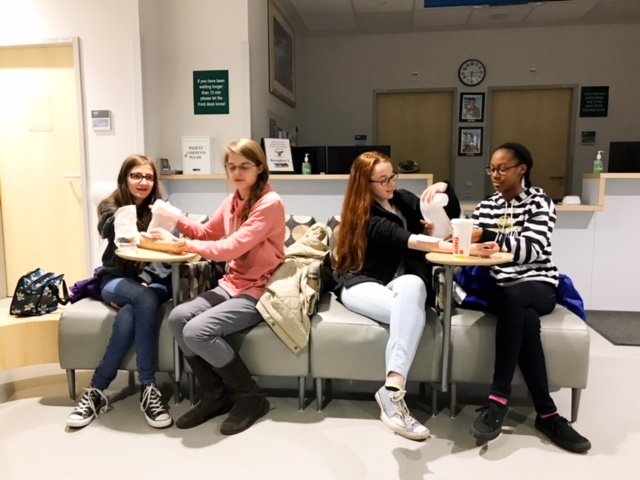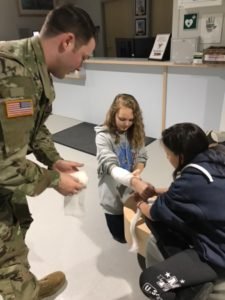
By Maj. Lisa Dennis
Executive Officer
Army Health Clinic Stuttgart Team

While many people look forward to cookie sales with Thin Mints and Samoas in mind, Girl Scouts are doing things year-round to better the world they live in and exemplifying the Girl Scout Law to be “considerate and caring, courageous and strong, and responsible for what I say and do.”
Recently, Girl Scout Troops 509, 530 and 571, consisting of Cadettes, Seniors and Ambassadors, had a unique opportunity to receive firsthand experience on combat and clinical medicine to earn their First Aid Badge. The Scouts practiced first aid training and participated in a combat medic question and answer session, speaking with Dr. (Capt.) Azfar Syed and combat medic Spec. Colby Hester, Army Health Clinic Stuttgart team.
“This is part of a Girl Scout patch requirement for the Ambassadors, the Seniors and the Cadettes, who are all earning level-appropriate first aid patches,” said Natasha Hodges. “This is part of the Girl Scout curriculum to target – care of a critically injured person, real life examples of caring for injured people, and to know what to do in an emergency situation.”

While discussing first aid, the topic of weather came up, leading to the girls and Health Clinic staff discussing different reactions to different weather patterns, along with the dangers of heat and cold climate related injuries. The lesson continued from a conversation about life saving in the wilderness to what to do if someone was overdosing from drugs or alcohol.
Hester explained that traditional emergency medical technology training takes six months, but that Army medics require only two months to complete the same training.
“Always do as much as you can to help a hurt or injured person in an emergency. Keep them calm and talk to them. If you cannot do this, then get help,” Hester said.
Hester and Syed, who recently returned from a tour in Afghanistan, covered an array of topics from how to rate injured Soldiers in a war zone to rendering basic first aid on a hike. The Scouts were taught how to wrap a wound with gauze and brainstormed other materials that they could use if sterile materials were unavailable.
“Capt. Syed and Spc. Hester have both spent time deployed to the Middle East, and their information regarding first aid will help these Girl Scouts assess emergency situations and make a decision about care for a person in need,” Hodges said .
Earning first aid badges is just one of many opportunities for the Scouts to unleash their inner G.I.R.L. (Go-getter, Innovator, Risk-taker, Leader). For more information about the Stuttgart area Girl Scouts, email stuttgartregistrar@gmail.com.
